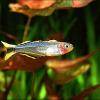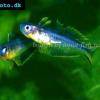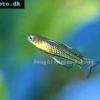Pacific blue-eye - Pseudomugil signifer
Scientific name: Pseudomugil signifer
Common name: Pacific blue-eye
Family: Pseudomugilidae
Usual size in fish tanks: 4 - 5 cm (1.57 - 1.97 inch)
014
Recommended pH range: 5.5 - 7.8
Recommended water hardness: 5 - 15°N (89.29 - 267.86ppm)
0°C 32°F30°C 86°F
Recommended temperature range: 21 - 28 °C (69.8 - 82.4°F)
The way how these fish reproduce: Spawning
Where the species comes from: Oceania
Temperament to its own species: peaceful
Temperament toward other fish species: peaceful
Usual place in the tank: Middle levels
Origin
Australia: The Pacific blue-eye is found in coastal streams from Northern Queensland to Southern New South Wales.
Lifespan
The expected lifespan for Pseudomugil signifer is 1-2 years.
Short Description
The Pacific Blue-eye (Pseudomugil signifer) is a versatile species that can adapt to a range of water conditions, including freshwater, brackish, and saltwater. However, they are sensitive to fluctuations in water parameters, so it's important to add them to a mature, stable aquarium. A smaller aquarium is suitable for these fish as long as it’s equipped with frequent water changes and a medium water flow. They prefer a planted environment with low lighting to help them feel secure. Floating plants are beneficial to diffuse light levels and provide additional cover. In open aquariums, they can become skittish due to feeling insecure. For ideal conditions, aim the filter outlets toward the water surface to increase gaseous exchange, providing well-oxygenated water.
Pacific Blue-eyes are peaceful and suitable for community tanks with fish of a similar size. They are a shoaling species, so it's best to keep them in small groups of at least 6 individuals. Larger fish may view them as prey, so care should be taken when choosing tank mates.
Food and Feeding
A quality flake food should serve as the staple diet for Pacific Blue-eyes. To keep them in good condition, provide bloodworms and brine shrimp 2-3 times a week. These treats ensure they receive a varied diet that meets their nutritional needs.
Sexing
Males have extended dorsal, anal, and pelvic fins, which will color up when they are in spawning mode. Females generally have shorter, less colorful fins.
Breeding
During spawning, males can become aggressive, so it's best to keep 2-3 females with each male. Include hiding places in the tank to help the females escape any unwanted attention. Adding Java moss or spawning mops to the breeding tank provides a substrate for the eggs to be scattered into. Spawning may occur over several days, with the female depositing only a few eggs at a time.
The eggs take up to 16 days to hatch and are relatively large compared to similar species. The fry can eat newly hatched brine shrimp as soon as they become free-swimming. For a higher success rate, move the eggs to a separate tank equipped with an air-driven sponge filter. Perform daily water changes and offer small meals 2-3 times per day once the fry are free swimming.
Picture
Bought by aqua-fish.net from jjphoto.dk.


 Connie’s
Connie’s  Forktail
Forktail  Spotted
Spotted